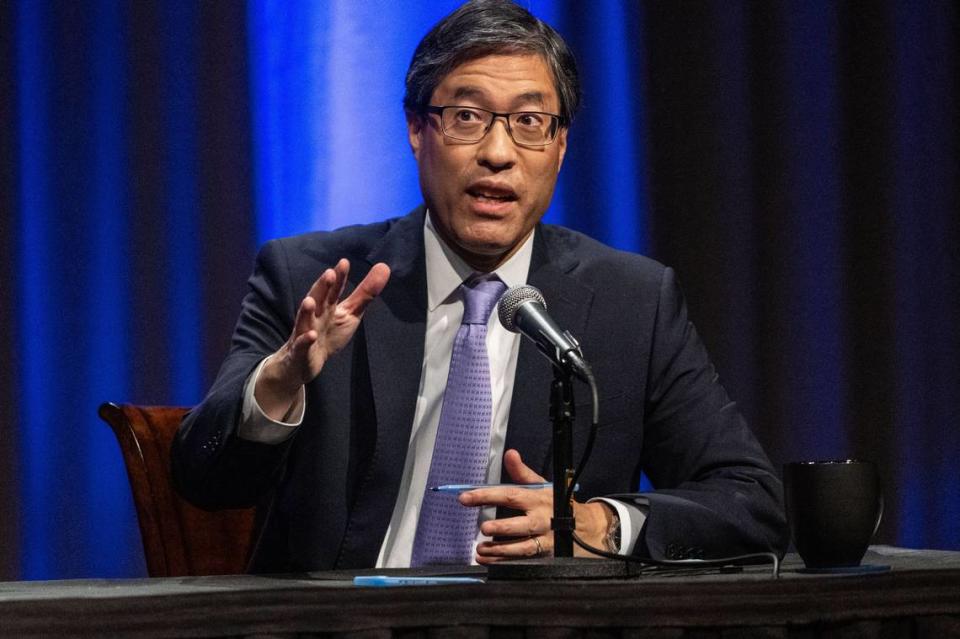Asian voters will be a driving force in Sacramento mayoral race, experts say
- Oops!Something went wrong.Please try again later.
In the Spotlight is a Sacramento Bee series that digs into the high-profile local issues that readers care most about. Story idea? Email metro@sacbee.com.
Asian voters were a driving force in the Sacramento mayoral primary in March, data from The Sacramento Bee shows, and experts say the demographic may help determine how the mayoral election turns out in November.
During the primary, Asian voter turnout exceeded Black and Latino in Sacramento, said Bill Wong, a Democrat strategist. This follows a trend which shows political involvement in Asian communities has increased in recent years, he added.
As with the general population, accessibility and increased popularity with mail-in ballots plays a role. With the increase in anti-Asian hate crimes, Asian communities are becoming more politically involved, said Wong.
“While Asian communities have been unified by fighting against anti-Asian hate. A shared interest in social justice has brought the group together as a “consolidated global AAPI identity,” he said.
“After multiple years, almost three and a half years of post COVID anti-AAPI hate, the Asian American community, statewide and nationally are far more engaged in politics then they’ve ever been,” Wong said.
Asian communities come together over a commonalities in political interest, they’re all vastly different and diverse from one another, said Kevin Liao, a Democrat strategist.
“These findings really show how the AAPI community is not a monolith,” said Liao. “It really shows for candidates, you can’t talk to the broader Asian American community in one way. You have to really dig into the cultural nuances behind each community. Figure out a unique message that’s going to resonate with each of them.”
Sacramento’s Asian population is growing fast, and becoming a bigger player in city politics.
About 106,000 Sacramento residents identified as Asian in 2022, up by about 20,000, or 24%, from a decade prior. By comparison, the rest of the city’s population grew by about 8% over the same time period. All told, about one in five of the city’s residents identify as Asian.
The city’s Asian population is not monolithic. About 21% identify as Chinese; 17% identify as Hmong; 14% identify as Filipino; 14% identify as Asian Indian and the remaining 33% identify with another Asian ethnic group, primarily Vietnamese, Japanese, Pakistani or Laotian.
Asian residents live throughout the city, but are most concentrated in a few neighborhoods: the southern end of the Pocket; Meadowview; Valley Hi and in and around Glen Elder and in parts of North Natomas, particularly near I-80.
It’s hard to extrapolate how Asian residents vote compared to the communities that surround them. Even in the communities where Asians are most prevalent, they are still usually a minority of residents, and their votes are lumped into totals with everyone else in their precincts.
Still, some patterns emerge when looking at the 38 voting precincts in city census tracts with the highest concentration of Asian residents.
In those precincts, Richard Pan did better than any other candidate, earning about 28% of the vote. Elsewhere in the city, he earned about 20% of the vote. Pan, who did not make the general election runoff for mayor, would have been the city’s first elected Asian American mayor.
The other three leading candidates for mayor - Flo Cofer, Steve Hansen and Kevin McCarty - each did worse in those precincts than in the rest of the city.
Again, though, the Asian community in Sacramento is not monolithic, and digging deeper into the data reveals other patterns.
Among the 38 precincts with the highest concentration of Asian residents, Pan won the most votes in communities where Chinese residents comprised the largest Asian ethnic groups.
Cofer won the most votes in communities where Hmong and Vietnamese residents comprised the largest Asian ethnic groups.
Communities where Asian Indians and Filipinos comprised the largest Asian ethnic group were almost evenly split between Cofer and Pan.
Income and class intersect with these patterns. Across the entire city, Cofer did best in lower- and middle-income areas.
Looking specifically at the 38 precincts with the highest concentration of Asian residents, Pan did best in middle-class and higher-income Asian communities largely located near the Pocket and North Natomas. Cofer did best in lower-income Asian communities largely located near Meadowview, Glen Elder and Valley Hi.
Wong said the economics of different Asian subgroups plays a role. The divide between Pan and Cofer with low income to higher income areas, shows that race is not the only deciding factor in someone’s political decision, he explained.
“If you’re in a lower income community, you are not going to relate to (someone from) Pocket or Greenhaven,” Wong said.
What does this mean for November?
There’s power in representation and having someone with culturally common life experiences—which was proven with the voter turnout for Pan, Wong said. Whenever there has been an Asian candidate, turnout has increased.
Pan, who could have been Sacramento’s first Asian mayor, is now out of mayoral race entirely. With him out, Asian Sacramento residents will have to decide on the two remaining candidates: Cofer and McCarty.
While a Pan endorsement could make the difference, alliances with public figures in Asian communities will also garner votes. For example, Cofer has a close relationship with Mai Vang, who serves a councilmember representing District 8 and is the daughter of Hmong refugees. In the past, Cofer has also down well with certain Southeast Asian communities, Wong said.
Endorsements by themselves doesn’t necessarily mean a guaranteed vote though, Wong said. Mailing ads to Asian voters will make the difference in outreach.
“It’ll rely heavily on whether or not those candidates are going to be able to obtain those endorsements and then utilize and serve them directly to the voters,” Wong said. “It’s one thing to have the endorsement, but if nobody sees your endorsement or hears about it, then it really doesn’t matter.”
Liao emphasized the importance of investing in Asian communities. Both Cofer and McCarty need to show up, listen to Asian communities and base community needs into their message.
For example, South Sacramento has a significant Vietnamese population and deserves attention when serving that population. Liao recommended the remaining candidates show up for Asian communities across Sacramento.
“Just spend time in the community, hear from people about what they care about, and then base your message on that,” Liao said.



